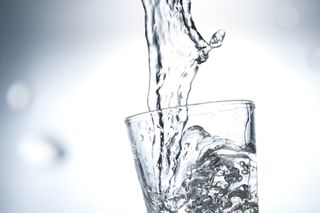How Drinking Too Much Water Put One Woman's Life In Danger

For women who have heard that drinking plenty of water can help prevent or treat a urinary tract infection, you may want to put down that extra glass: A woman in England ended up in the hospital after loading up on liquids to keep a UTI at bay, according to a new report of her case.
The 59-year-old woman went to the emergency room in October 2015 to get antibiotics for a UTI, according to the report. After she received her antibiotics, she intended to go home and rest, but because she felt increasingly lightheaded and sick, her partner persuaded her to stay at the hospital.
The woman developed trouble speaking and finding words, and became distracted, doctors wrote in the report of her case, published today (Dec. 1) in the journal BMJ Case Reports. Her partner told the doctors that she had drunk several liters of water that day, according to the report. [7 Foods You Can Overdose On]
The patient herself commented in the report that she was no stranger to UTIs. "I have, since my 20s, had periods where cystitis [inflammation of the bladder] and related UTIs have flared up," she wrote.
So when she woke up one Sunday morning and felt a "dull 'thumbprint' pressure" in her lower abdomen, she followed her usual protocol, which meant "(a) drink lots of water and (b) get to the doctor or [emergency room] quickly to get antibiotics," she wrote.
The woman wrote that she recalled receiving advice to drink half a pint of water every half hour. But she drank even more, she wrote. "I am sure I exceeded the 'half-a-pint-every-half-hour' advice," she added.
The woman wrote that after her partner persuaded her to stay at the hospital after receiving her antibiotics, it was "the end of any accurate memory [she had] of the day."
Sign up for the Live Science daily newsletter now
Get the world’s most fascinating discoveries delivered straight to your inbox.
Sodium: A balancing act
When a person drinks too much water, he or she can develop a dangerous condition called hyponatremia, the doctors who treated the woman wrote in the report. Hyponatremia means that the levels of sodium, an important electrolyte, in a person's blood are too low.
Normally, the salts in a person's blood "are in a very delicate balance with each other to keep the water in your body in the right areas," said Dr. Maryann Noronha, an emergency-medicine physician at the Royal London Hospital in England and the senior author of the report. Noronha and her colleague, Dr. Laura Lee, treated the patient.
"If the amount of sodium in your blood falls, this makes [the blood] more dilute than other areas, meaning that water will be pulled out of your blood vessels into areas that are more concentrated as the body tries to balance things out again," Noronha told Live Science.
"One of the areas most vulnerable to this is your brain, which can become swollen as water enters it in an effort to even out the sodium levels," Noronha added. This swelling can lead to symptoms such as confusion and speech problems, according to the report. The condition can be deadly if it develops quickly and is not treated, Noronha said.
Noronha noted that she has seen many cases of hyponatremia in her 10 years of medical practice, so the condition was on her list of possible diagnoses for the woman. However, she also wanted to rule other dangerous conditions, such as a stroke, Noronha said.
"Hyponatremia can be very non-specific in its symptoms and can mimic many other conditions. It can also accompany many other illnesses, so it can sometimes be difficult to spot," she added. [Here's a Giant List of the Strangest Medical Cases We've Covered]
But if you know to test for low sodium levels, however, a simple blood test can spot the condition.
Treating low sodium levels depends on what caused the condition in the first place, Noronha said. In the woman's case, for example, the cause was straightforward: the sodium levels had been diluted down by excess water, she said. If this is the cause, the main treatment is "often simply water restriction," she said. If the condition occurs "because there truly is not enough sodium in the body, then the treatment can get more complicated," Noronha added.
The doctors treated the woman by restricting her water intake to 1 liter for 24 hours. Thirteen hours into the treatment, her sodium levels had increased to a normal level, and the woman was discharged later that day, according to the report.
Indeed, the woman wrote that "something like 24 hours [after being admitted] I was bored, a sure sign I was on the mend!" She added that "it took about a week to feel 'normal' again" and was tired for at least another week after that.
The doctors last spoke with the woman several months ago and "were pleased to find that she was fully recovered," Noronha said.
Since treating the woman, Noronha said that she now tries to be a bit more specific when advising patients about how much water they should drink. "It is important to stay well-hydrated during any acute illness to balance the effects of a [fever] and the infection in the body," but this can be achieved by maintaining "normal fluid intake and [thinking] about drinking maybe half again on top of that," she said.
Originally published on Live Science.

Most Popular



